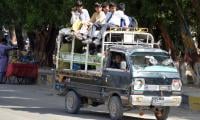Lahore
The International Snow Leopard Summit and Ecosystem Forum held in Bishkek, Kyrgyzstan, from August 23-25 ended with a declaration that focused on WWF’s (World Wide Fund for Nature) call for an integrated approach to preserve snow leopard habitat.
The Bishkek declaration called upon world leaders from the 12 snow leopard range countries (Afghanistan, Bhutan, China, India, Kazakhstan, Kyrgyzstan, Mongolia, Nepal, Pakistan, Russia, Tajikistan, Uzbekistan) to bolster previous commitments, or risk irreversible damage to both the species and landscape.
The summit was held after four years since the range countries first met in 2013, where they committed to an ambitious goal of securing 20 snow leopard landscapes by 2020 — three of which fall in Pakistan.
This has brought the plight of the iconic species into the spotlight and created hope that the commitment from the range country governments could set an example of conservation success worldwide. However, at the half-way point, there remain as few as 4,000 snow leopards and its habitat, which is home to the headwaters of 20 major rivers in Asia and known as the ‘world’s water towers’, continues to shrink.
Speaking on the last day of the summit, Marco Lambertini, Director General at WWF International, said: “The snow leopard range countries could write one of the greatest success stories of modern conservation.
They have made promising progress to begin safeguarding the 20 landscapes by 2020 but we now reach a critical check point. Efforts must be increased or the goal will not be achieved, with snow leopards and local communities feeling the consequences.”
“This summit sets the stage for snow leopard range states to raise the bar and take strong action now to prevent permanent damage and build resilience for snow leopards and their habitats, alongside the ambitions of also developing local economies and livelihoods. Appreciating the countless bounties that nature provides and firmly remembering that the fate of humanity is closely intertwined with nature is crucial for the future of our living planet. Securing the future of snow leopards, the undisputed symbol of the high mountains of Asia, is a part of acknowledging not just our interdependence but our moral responsibility towards nature,” Lambertini added.
The summit provided a rare opportunity to address two of the greatest emerging threats for the snow leopard and its vital habitat; climate change and unsustainable infrastructure development, both of which transcend far beyond political borders of countries and need a united approach to succeed. Recent research suggests that climate change could wipe out more than two thirds of snow leopard habitat in the next fifty years. This, coupled with infrastructure projects which could cut ribbons across many of the snow leopard landscapes, mean the coming years will push the species even closer to the brink of survival.
According to a survey carried out in 2013 by the Global Snow Leopard and Ecosystem Protection Program (GSLEP), climate change and habitat loss due to human activities were termed as the main reasons behind the decline of numbers in the snow leopard population.
In Pakistan human-wildlife conflict has been termed as the major cause of the dwindling numbers, which according to a recent estimate stands between 240 - 400 left in the wild.
In this still, Punjab Chief Secretary Zahid Akhtar Zaman chairs a meeting on April 19, 2024. — Facebook/Chief...
In this still, Minister for Social Welfare and Baitul Maal Sohail Shaukat Butt places Ali Hamza on a wheelchair on...
A general view of the Lahore University of Management Sciences . — LUMS Website/FileLAHORE:The Syed Ahsan Ali and...
Punjab University building in Lahore. — Facebook/Punjab University/File LAHORE: The Executive Council of the...
An undated picture of Pakistani female athletes running on a track. — Athletics Federation of Pakistan...
The Punjab Assembly building in Lahore. — Geo.tv/ fileLAHORE: The Punjab Assembly has commenced its pre-budget...







